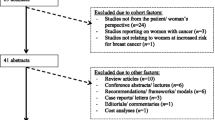Abstract
Background: The National Surgical Adjuvant Breast and Bowel Project (NSABP) P-1 trial demonstrated that tamoxifen reduces the incidence of new breast cancers by 49% in women at increased risk for breast cancer development. Tamoxifen does have side effects, however, including marginally increased risks of endometrial cancer and thromboembolic events. In this study, women at increased risk for breast cancer development were offered tamoxifen. Their knowledge of tamoxifen as a chemopreventive agent was assessed, and factors influencing their acceptance of tamoxifen and willingness to take it were determined.
Methods: Forty-three patients were identified who qualified to take tamoxifen for primary prevention. Patients qualified by having at least a 1.7% 5-year risk of developing breast cancer, the criteria for entry into the NSABP P-1 trial. Patients initially completed questionnaires designed to assess their knowledge of tamoxifen and its associated risks and benefits. Patients were then provided neutral educational sessions and literature delineating the actual risks and benefits of tamoxifen. Subsequently, patients’ decisions regarding taking tamoxifen were reassessed.
Results: Mean patient age was 52.8 years, with a range of 39 to 74 years. Ten patients (23.2%) qualified based on the presence of lobular carcinoma in situ (LCIS), seven patients (16.3%) qualified based on increased risk secondary to age >60 years, and 26 patients (60.5%) age range 35 to 59 qualified based on risk profiles demonstrating significantly increased risk. Of the total 43 patients, two (4.7%) elected to start taking tamoxifen. Fifteen patients (34.8%) declined immediately, and 26 patients (60.5%) were undecided initially but ultimately declined. Educational sessions did not influence patients’ decisions. Fear of side effects, including endometrial cancer, thromboembolic events, and menopausal symptoms, was the most commonly cited reason for declining to take tamoxifen.
Conclusions: In this study, the vast majority of patients at increased risk for breast cancer perceived that the risks of taking tamoxifen outweighed the benefits and declined to take it.
Similar content being viewed by others
REFERENCES
Greenlee RT, Murray T, Bolden S, Wingo P. Cancer statistics, 2000.2 CA Cancer J Clin 2000; 50: 7–33.
Spicer DV, Pike MC. Risk factors.In: Roses DF, ed. Breast Cancer. Philadelphia: Churchill Livingstone, 1999: 47–54.
Early Breast Cancer Trialists’ Collaborative Group. Tamoxifen for early breast cancer: an overview of the randomized trials. Lancet 1998; 351: 1451–67.
Benichou J, Gail MH, Mulvihill JJ. Graphs to estimate an individualized risk of breast cancer. J Clin Oncol 1996; 14: 103–10.
Fisher B, Constantino JP, Wickerham DL, et al. Tamoxifen for prevention of breast cancer: report of the National Surgical Adjuvant Breast and Bowel Project P-1 Study. J Natl Cancer Inst 1998; 90: 1371–88.
Gail MH, Costantino JP, Bryant J, et al. Weighing the risks and benefits of tamoxifen treatment for preventing breast cancer. J Natl Cancer Inst 1999; 91: 1829–46.
Bernstein L, Deapen D, Cerhan JR, et al. Tamoxifen therapy for breast cancer and endometrial cancer risk. J Natl Cancer Inst 1999; 91: 1654–62.
Veronesi U, Maisonneuve P, Costa A, et al. Prevention of breast cancer with tamoxifen: preliminary findings from the Italian randomized trial among hysterectomized women. Lancet 1998; 352: 93–7.
Powles T, Eeles R Ashley S, et al. Interim analysis of the incidence of breast cancer in the Royal Marsden Hospital tamoxifen randomised chemoprevention trial. Lancet 1998; 352: 98–101.
Osman LM. How do patients’ views about medication affect their self-management in asthma? Patient Educ Couns 1997; 32: S43–9.
McInnes GT. Integrated approaches to management of hypertension: promoting treatment acceptance. Am Heart J 1999; 138: S252–5.
Grann VR, Jacobson JS, Whang W, et al. Prevention with tamoxifen or other hormones versus prophylactic surgery in BRCA1/2-positive women: a decision analysis. Cancer J Sci Am 2000; 6: 13–20.
Osin P, Gusterson BA, Philp E, et al. Predicted anti-oestrogen resistance in BRCA-associated familial breast cancers. Eur J Cancer 1998; 34: 1683–6.
Narod SA, Brunet JS, Ghadirian P, et al. Tamoxifen and risk of contralateral breast cancer in BRCA1 and BRCA2 mutation carriers: a case-control study. Hereditary Breast Cancer Clinical Study Group. Lancet 2000; 356: 1876–81.
McKenney JT. Methods of modifying compliance behavior in hypertensive patients. Drug Intell Clin Pharm 1981; 15: 8–14.
Hunt LM, Valenzuela MA, Pugh JA. NIDDM patients’ fears and hopes about insulin therapy, the basis of patient reluctance. Diabetes Care 1997; 20: 292–8.
Cummings SR, Eckert S, Krueger KA, et al. The effect of raloxifene on risk of breast cancer in postmenopausal women: results from the MORE randomized trial. Multiple Outcomes of Raloxifene Evaluation. JAMA 1999; 281: 2189–97.
Author information
Authors and Affiliations
Rights and permissions
About this article
Cite this article
Port, E.R., Montgomery, L.L., Heerdt, A.S. et al. Patient Reluctance Toward Tamoxifen Use for Breast Cancer Primary Prevention. Ann Surg Oncol 8, 580–585 (2001). https://doi.org/10.1007/s10434-001-0580-9
Received:
Accepted:
Issue Date:
DOI: https://doi.org/10.1007/s10434-001-0580-9




